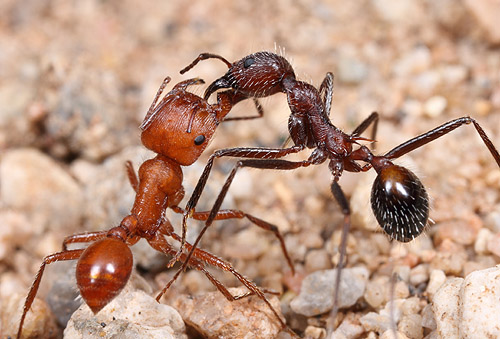 Pogonomyrmex badius Harvester Ants
Pogonomyrmex badius Harvester Ants
Archbold Biological Station, Florida, USA
Photo details: Canon MP-E 65mm 1-5x macro lens on a Canon EOS 50D.
ISO 100, f/13, 1/250 sec, diffused twin flash
Posted in Ants, Nature, tagged Ants, Photography, Pogonomyrmex on January 30, 2010| 3 Comments »
 Pogonomyrmex badius Harvester Ants
Pogonomyrmex badius Harvester Ants
Archbold Biological Station, Florida, USA
Photo details: Canon MP-E 65mm 1-5x macro lens on a Canon EOS 50D.
ISO 100, f/13, 1/250 sec, diffused twin flash
Posted in Ants, arizona, tagged Ants, Aphaenogaster, biology, Nature, Photography, Pogonomyrmex on August 10, 2009| 3 Comments »

Pogonomyrmex maricopa (at left) tussles with an Aphaenogaster albisetosa at the Aphaenogaster nest entrance.
While in Arizona, I chanced upon a set of ant fights that I’d observed several times previously. Single workers of the maricopa harvester ant Pogonomyrmex maricopa would approach a nest of their competitor, Aphaenogaster long-legged ants, and spend a few minutes drawing heat from the guards before wandering off.

Same thing, but different individuals (note differences in limb wounds from the previous photo)
The interaction is common enough that it really couldn’t be just a chance encounter. Are the Pogos doing this for a reason? Are they distracting the Aphaenogaster from foraging? And, are there any myrmecology students in Arizona who need a little research project? It’d be great to figure out the purpose of the fights.

Three on one. Do the Pogos subject themselves to this treatment as a decoy, to draw Aphaenogaster away from shared foraging territory?
photo details (all photos): Canon mp-e 65mm 1-5x macro lens on a Canon EOS 50D
ISO 100, f/13, 1/250 sec, twin flash diffused through tracing paper
Posted in Ants, Blogging, Navel-Gazing, tagged Pogonomyrmex on July 10, 2009| 6 Comments »
No, I haven’t forgotten you all. We’re still busy moving to the new house. Blogging will remain slow until we get the internet connected, and given the way that AT&T has managed to botch just about everything else so far I don’t know if that will happen any time soon. (There’s really nothing like the sluggish, incompetent service that AT&T provides. But, at least it’s overpriced.)
If you need an ant fix, click on this for a slide show of Pogonomyrmex harvester ants.
Posted in Ants, Science, Taxonomy, tagged Ants, Argentina, Evolution, Pogonomyrmex on April 25, 2009| 4 Comments »

Pogonomyrmex micans, Santiago del Estero, Argentina
Ants of the genus Pogonomyrmex (“Pogos”) are known to myrmecologists as the classic harvester ants of North American deserts. They are conspicuous insects, the most noticeable of the desert ants, and something of a model organism for studies of ecology. Numerous scientific papers on pogos are published each year, and one species- Pogonomyrmex californicus– is mailed to school classrooms around the country to populate those plastic ant farms.
It’s easy to forget amidst the celebrated riches of North American pogos that South America also holds a great number of species. In fact, it is likely that the genus first arose in South America; the southern pogos display a greater variety of morphologies and inhabit a broader swath of habitats.
Yet, these austral pogos are largely ignored. Consider the results of a quick google search:
Posted in Ants, arizona, Insect Links, Photography Links, Science, tagged animal behavior, ant fights, entomology, natural history, Pogonomyrmex, ritual combat on October 12, 2008| 1 Comment »
Here’s a question for my myrmecologist readers. Has anyone published observations of ritualized fighting among colonies of Pogonomyrmex harvester ants? I know such behavior was famously studied by Bert Hoelldobler in Myrmecocystus, and that ritual combat has been noted in Camponotus and Iridomyrmex. The reason I ask is that the pogos in my front yard back in Tucson would engage in what looks like the same sort of behavior. Ants from opposing colonies stand up on little stilt-legs and push each other about without anyone getting hurt.

I suspect these non-lethal ways of establishing territorial boundaries may be more common among ants than we’d thought, and if no one has recorded ritual combat in Pogonomyrmex it should be worth publishing a note somewhere. More photos below the fold. (more…)
Posted in Ants, arizona, Insect Links, Photography Links, Science, tagged Biology Links, desert, entomology, Nature, Pogonomyrmex on March 19, 2008| 4 Comments »

In our front yard we’ve got a busy nest of Pogonomyrmex rugosus seed harvesting ants. Warming weather brought them out for the first time last week, and every now and again I go out to see what they’re up to. Lots of digging, it seems.
Pogonomyrmex is greek for “Bearded Ant”, named 150 years ago by Austrian myrmecologist Gustav Mayr for the thick brush of hairs on the underside of the head. Entomologists affectionately refer to these ubiquitous desert insects as “Pogos”. What does the beard do?